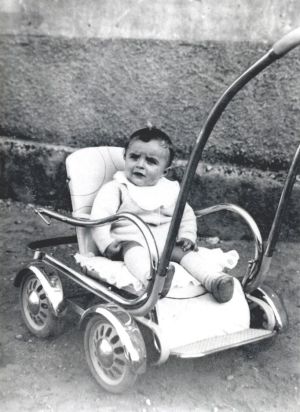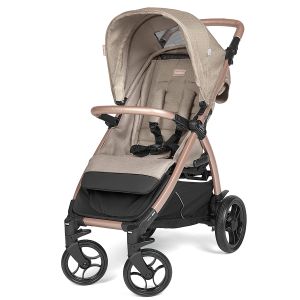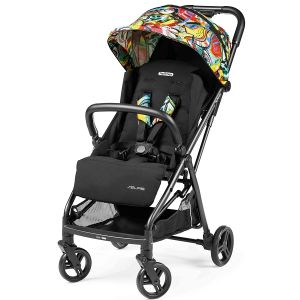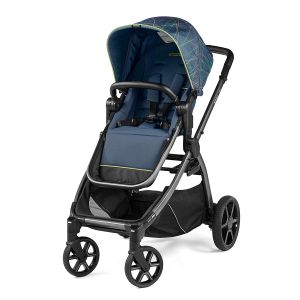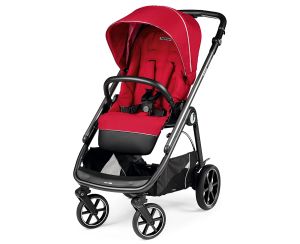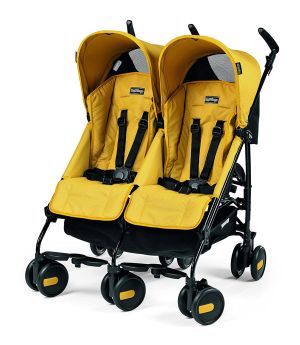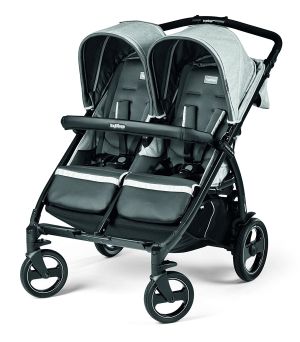Peg Perego
StrollerWiki is reader-supported. Things you buy through our links may earn us an affiliate commission. StrollerWiki.com is a participant in the Amazon Services LLC Associates Program, an affiliate advertising program designed to provide a means for sites to earn advertising fees by advertising and linking to Amazon.com and its related sites. As an Amazon Associate, we earn from qualifying purchases.
Peg Perego, an Italian stroller brand, is one of the few stroller makers worldwide that does not produce its strollers in China.
The company was founded in 1949 by Giuseppe Pérego, who designed a baby carriage for his son. Unlike other strollers that used wicker and sheet metal, Perego used "rubberized fabric" as the seat base. The strollers proved to be popular and the Peg Perego company was launched.
The company expanded into different juvenile categories in the 1970's and 1980's, including car seats, high chairs and toys (ride-on vehicles).
Peg Perego was among the first European stroller brands to expand sales to the US, landing in the US in the 1960's. The company set up shop in Fort Wayne, Indiana in 1968.
Why Fort Wayne? Nick Perego, grandson of Giuseppe Pérego, explained in an interview with the Fort Wayne Business Weekly in 2019[1]:
"Having operations in Toronto, Indiana looked like a perfect fit because of the logistical aspects of being in center of the country. Also we had a need to be close to Chicago where Sears was headquartered. Sears was pretty much the Amazon of the time.”[2]
Unlike other stroller brands that off-shore production to China, Peg Perego strollers are still made in the company's factories outside Milan, Italy (textiles for its strollers are made in a company-owned facility in Romania). The only exception to European production was a brief time during the 2000's when Perego made one model, the Aria, in China.
Peg Perego's heyday sales-wise was in the 1980's and 90's, when its strollers dominated the premium stroller category. In the 2000's, increased competition in that segment from Bugaboo and UPPAbaby dimmed the company's fortunes to some degree. The company was also slow to innovate, only joining the modular (single-to-double) and ultra-compact stroller segments long after the competition came to market.
In recent years, Peg Perego rolled out a sub-brand, Agio that marketed the same strollers as Perego, with somewhat different colors/fashions and an enhanced warranty. Peg Perego offers a 2-year warranty, while Agio offers a 5-year warranty.
Peg Perego strollers can be divided into four categories: single-to-double strollers, full-size, compact and double strollers.
Flagship Model: Booklet 50
The Booklet 50 (20 lbs., see latest price on Amazon) is a classic Perego stroller—lightweight with a compact, one-hand, self-standing fold. It works natively with the Peg Perego line of infant car seats.
The Peg Perego Booklet 50 is 20 inches wide, providing mobility through narrow store aisles or crowded sidewalks. The extendable hood of the stroller is UPF 50 + and has a protective visor. The wheels have ball bearings and a suspension system, for a smoother ride over rough terrain. The basket is expandable, although it is hard to access when the seat is reclined.
The plastic wheels on the Booklet 50 are somewhat unusual in this price range, as are the lack of convenience items like a cup holder or rain cover (both available as extra accessories).
Other Peg Perego models: Selfie, Ypsi/Stroller Z4, Veloce
The Peg Perego Selfie (19.8 lbs, see latest price on Amazon) is an ultra-compact stroller:
- Lightweight and compact: The Selfie weighs just 19.8 lbs. and folds up to a compact size that can easily be stored in the trunk of a car or carried onto public transportation.
- Self-folding: The Selfie folds automatically with just a push of a button, making it easy to store and transport.
- One-handed operation: The Selfie can be opened, closed, and steered with just one hand.
- Adjustable seat: The Selfie's seat can be reclined to multiple positions.
- Large canopy.
- Compatible with car seats: The Selfie can be used with select Peg Perego car seats, without the need of an adapter.
The Peg Perego Ypsi (22.5 lbs., also known as the Agio Z4, see latest price on Amazon) is a full-featured, expandable stroller that features a reversible seat facing the parent or facing the world, a large canopy that provides shade from the sun, and a reclining seat that can be adjusted to multiple positions. The Ypsi also has a large basket for storing baby gear, and it folds compactly for easy transport.
The Ypsi is also a single-to-double stroller—a "companion seat" can be added as an accessory. Hence, this model is much like the UPPAbaby Vista. Here are some of the key features of the Peg Perego Stroller Ypsi:
- Reversible seat: The seat can be used facing the parent or facing the world.
- Large canopy: The canopy provides shade from the sun and has a peek-a-boo window so you can check on your child without disturbing them.
- Reclining seat: The seat can be reclined to multiple positions.
- Large basket.
- Compact fold: It folds compactly for easy transport, making it perfect for travel or storing in small spaces.
Confusingly, Perego markets Ypsi also as the Z4 and sometimes as the Agio Z4. While these are identical models, the Ypsi comes in different colors (4 for the Z4 versus 6 for the Ypsi). The Z4 is priced somewhat higher than the Ypsi by about $50.
The Peg Perego Veloce (23.75 lbs., see latest price on Amazon) is also in the full-featured part of the Perego line and features a reversible seat. It has large wheels in back and smaller wheels in front, similar to Bugaboo models.
The Peg Perego Vivace (20.7 lbs., see latest price on Amazon) is similar to the Veloce, as it also has a reversible seat. However, it is somewhat lighter in weight (by 3 lbs.) and narrower in width. It also has smaller back wheels.
Double Strollers: Pliko Mini Twin, Book for Two, Duette Piroet
Peg Perego has long marketed strollers for multiples, with both side-by-side and tandem (front/back) models.
Pliko Mini Twin (24 lbs., see latest price on Amazon) is a lightweight, compact side-by-side double stroller. It weighs just 24 lbs. and folds compactly (38.25" x 30.25" 21"). Each side has an independent canopy with mesh at the back for ventilation. The storage basket is somewhat small and shallow, with a bar at the back that somewhat blocks access. When the seats are reclined, it is also difficult to access the basket.
The Book For Two (30 lbs., see latest price on Amazon) is also a side-by-side double stroller with a notable differences when compared with the Pliko Mini Twin. The Book for Two is car seat compatible (and can hold two infant seats at the same time). It also has a single handlebar in back (versus the umbrella style handles of the Pliko.)
The Book for Two has seats with independent canopies and a basket that is more accessible compared to the Pliko. Other features include larger polyurethane wheels in back with smaller wheels up front. The narrow 29" width allows this stroller to fit through most doorways. On the downside, the Book For Two weighs six more lbs. than the Pliko Mini Twin.
The Duette Pireot (44.7 lbs., see latest price here) is a tandem (front/back) model with seats that can face forward or rear—the seats sit on a frame and operate independently. So the seats could face each other, or both face the parent and so on. The frame can also accommodate two infant car seats.
The Duette Pireot also can fold with or without the stroller seats and has canopies above the seats. Like the Book for Two, there are larger polyurethane wheels in back with smaller wheels up front.
Safety Recalls
In 2012, Peg Perego recalled 223,000 strollers due to a risk of entrapment and strangulation. "The recall involves two different older versions of the Peg Perego strollers, Venezia and Pliko-P3, manufactured between January 2004 and September 2007, in a variety of colors. They were manufactured prior to the existence of the January 2008 voluntary industry standard which addresses the height of the opening between the stroller's tray and the seat bottom. The voluntary standard requires larger stroller openings that prevent infant entrapment and strangulation hazards," said the CPSC.[3]
"A 6-month-old baby boy from Tarzana, Calif. died of strangulation after his head was trapped between the seat and the tray of his Peg Perego stroller in 2004. Another baby, a 7-month-old girl from New York, N.Y., nearly strangled when her head became trapped between the seat and the tray of her stroller in 2006," said the CPSC.
"Entrapment and strangulation can occur, especially to infants younger than 12 months of age, when a child is not harnessed. An infant can pass through the opening between the stroller tray and seat bottom, but his/her head and neck can become entrapped by the tray. Infants who become entrapped at the neck are at risk of strangulation."
Factory Sale
Peg Perego holds twice-a-year factory sales at their Fort Wayne, Indiana warehouse. In previous years, the sale was in April and November.[4]
StrollerWiki is reader-supported. Things you buy through our links may earn us an affiliate commission. StrollerWiki.com is a participant in the Amazon Services LLC Associates Program, an affiliate advertising program designed to provide a means for sites to earn advertising fees by advertising and linking to Amazon.com and its related sites. As an Amazon Associate, we earn from qualifying purchases.
- ↑ https://www.fwbusiness.com/news/latest/article_3c53d0c4-958e-5d7e-974a-c46f152a91f6.html
- ↑ https://www.fwbusiness.com/news/latest/article_3c53d0c4-958e-5d7e-974a-c46f152a91f6.html
- ↑ https://www.cpsc.gov/Recalls/2012/Peg-Perego-Recalls-Strollers-Due-to-Risk-of-Entrapment-and-Strangulation-One-Child-Death-Reported
- ↑ https://www.news-sentinel.com/living/2018/04/13/peg-perego-spring-sale-in-fort-wayne-brings-smiles-to-little-ones-faces/
